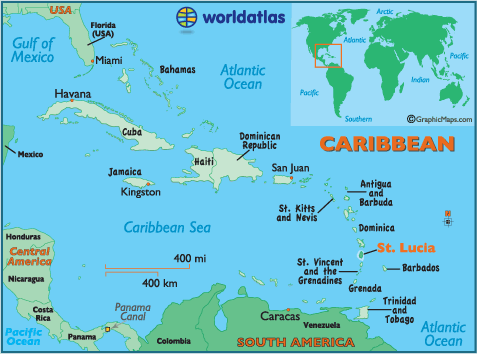Saint Lucia
Area 238 square mi (616 square km)
Population 183,600 2014
Capital Castries
Highest Point 3,135 ft (950 m)
Lowest Point 0 m
GDP $1.404 billion 2014
Primary Natural Resources forests, minerals (pumice), geothermal potential.
THE COUNTRY OF SAINT LUCIA is the secondlargest and the most picturesque of the Windward Islands. The island is known for its beauty and one of the most spectacular landscapes in the Caribbean region. Local legend attributes the name to Christopher Columbus's discovery of the island on the feast day of Saint Lucy (December 13, 1502), though his own ships' records do not concur. Settlement attempts were made by both Britain and FRANCE in the mid-17th century but were initially repelled by indigenous Carib Indians. Its excellent natural harbor made the island an obvious chip in the numerous treaty exchanges between Britain and France over the following two centuries, and it changed hands 14 times. As a result, Saint Lucia has one of the most mixed Anglo-French cultures of the region—Britain held the island from 1814 until independence in 1979, but most Saint Lucians retain French customs in language and religion (the local patois language called Kweyol and Roman Catholicism).

Like its neighbors, MARTINIQUE (24 mi or 39 km to the north), and SAINT VINCENT (21 mi or 34 km to the south), Saint Lucia is volcanic in origin and maintains active zones, most notably the collapsed volcanic cone located near the town of Soufriere, the world's only “drive-up volcano,” complete with boiling sulfur springs called soufrieres. The twin peaks of Gros and Petit Piton, volcanic cones rising abruptly from the sea to heights of 2,619 and 2,461 ft (794 and 746 m) respectively, are considered among the most beautiful spots in the Caribbean.
Due to the ruggedness of the terrain, most of the island was unsuitable for development by colonial plantation ventures and therefore remains forested and attractive to tourists. Several forest reserves and coastal nature reserves have been established (mostly in the east), and scuba diving has become increasingly popular (in the western, or leeward, side of the island, sheltered from the ATLANTIC currents). Rainforests shelter wild orchids, giant ferns, and brightly colored birds, including the island's national symbol, the Saint Lucian parrot. The east coast is home to leatherbacks, or giant sea turtles, and the fer-de-lance, a snake whose bite can sometimes be fatal.
Some valleys blessed with rich volcanic soil and abundant streams, were cultivated for bananas starting in the 1920s, and exports of this fruit dominated the economy until recently. Saint Lucia has the largest banana crop in the Windward Islands, mostly headed for the UNITED KINGDOM, where the market protects many of its former colonies. But Britain's changing position in the EUROPEAN UNION (EU) and the EU's changing protection laws will affect this, leading the drive to diversify through tourism and offshore banking.
As a result, Saint Lucia today has one of the most stable and diverse economies in the Caribbean, with a range of small manufacturing industries producing items like clothing and electronic components, plus agricultural products, from limes to coconuts. Hurricanes are an annual threat, and recent devastation has highlighted this fragility: Tropical Storm Debbie wiped out about 70 percent of the banana crop in 1994, only to be followed a year later by storms Iris and Luis.
The capital, Castries, is located on the northwest coast. It was built in 1768 and named for the French minister of naval and colonial affairs. It developed as an important coaling station on the PANAMA CANAL route, and is now an oil storage and transshipment point. Four-fifths of the town was wiped out by a fire in 1948, and much was rebuilt in concrete. The UNITED STATES established air and naval bases on Saint Lucia in World War II (primarily to protect shipping lanes to the Panama Canal) and continues to lease bases on the island. A new deepwater container port was opened at Vieux Fort at the southern tip of the island in 1993, and there are plans to establish this as a free zone for international trade.